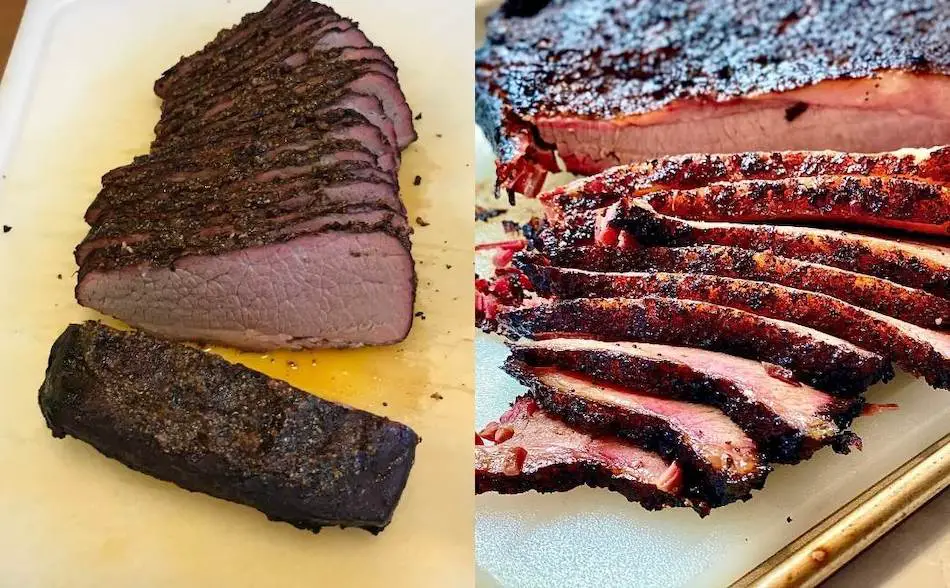
Barbecue enthusiasts and pitmasters everywhere are buzzing about the hot-and-fast method for cooking brisket. This technique promises to deliver delicious, tender brisket in a fraction of the time it takes to cook using the traditional low and slow method. But is it worth the hype? To find out, we delved into the details of these two methods and compared their pros and cons. If you’re wondering whether the hot and fast method is right for you, read on to learn more about the differences between these two techniques and how they affect the final product.
There are two main methods for cooking brisket: hot-and-fast, or low-and-slow. Hot-and-fast brisket is cooked at higher temperatures for shorter periods of time, and can be finished in half a day. Low-and-slow brisket is cooked at lower temperatures for longer periods of time, and takes a full day or longer to finish. A low-n-slow brisket is more tender, has a smokier flavor, a well-developed bark, and a more prominent smoke ring, whereas a hot-and-fast brisket results in less smoke flavor and may not be as tender. However, a hot and fast brisket will be cooked in half the time.
Key Points
Hot-and-fast brisket:
- Cooked at higher temperatures (350°F-400°F) for shorter periods of time (3.5-6 hours)
- Can be finished in half a day
- Has less smoke flavor
- May be less tender, especially in the brisket point
- Can be made more moist and juicy by injecting with broth or marinade, wrapping during cooking, and salting the day before
Low and slow brisket:
- Cooked at lower temperatures (220°F-250°F) for longer periods of time (10-12 hours or longer)
- Takes a full day or longer to finish
- Has a smokier, beefier flavor
- Is more tender and juicy, especially in the brisket point
- Has a more prominent smoke ring and a more developed bark
| Feature | Hot and Fast Brisket | Low and Slow Brisket |
|---|---|---|
| Cooking Temperature | 350°F-400°F | 220°F-250°F |
| Cooking Time | 3.5-6 hours | 10-12 hours or longer |
| Flavor | Less smoke flavor | Smokier, beefier flavor |
| Tenderness | May be less tender, especially in the brisket point | More tender, especially in the brisket point |
| Juiciness | Can be made more moist and juicy with injection, wrapping, and salting | More naturally tender and juicy |
| Smoke Ring | Not as prominent | More prominent |
| Bark | Not as developed | More developed |
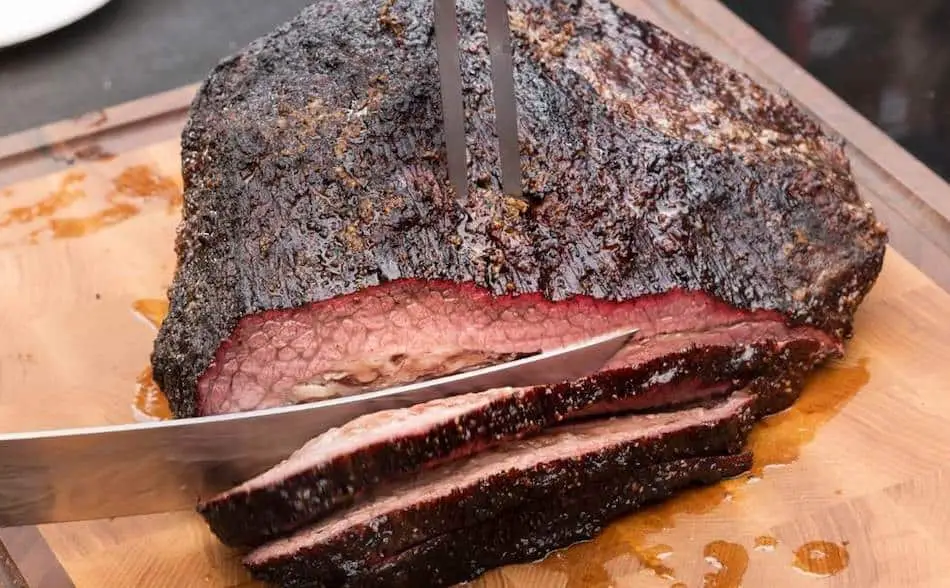
The Pros and Cons of both methods
| Feature | Hot and Fast Brisket | Low and Slow Brisket |
|---|---|---|
| Cooking Temperature | 350°F-400°F | 220°F-250°F |
| Cooking Time | 3.5-6 hours | 10-12 hours or longer |
| Flavor | Less smoke flavor | Smokier, beefier flavor |
| Tenderness | May be less tender, especially in the brisket point | More tender, especially in the brisket point |
| Juiciness | Can be made more moist and juicy with injection, wrapping, and salting | More naturally tender and juicy |
| Smoke Ring | Not as prominent | More prominent |
| Bark | Not as developed | More developed |
| Total Cook Time | Half a day or less | Full day or longer |
| Requires constant supervision | No | Yes |
| Can be cooked overnight | No | Yes |
| Suitable for large gatherings or parties | Yes | Yes |
Does a hot-and-fast brisket still have flavor?
A slow-smoked brisket cooked using the low and slow method will have a stronger, smokier, and beefier flavor compared to a hot and fast brisket. This is because the low and slow method allows the brisket to absorb more smoke flavor over a longer period.
Typically, a low and slow brisket is cooked at a temperature of around 220°F and spends about 7 to 8 hours on the grill or smoker before it is wrapped. During this time, the smoke has a chance to penetrate the meat and infuse it with flavor.
On the other hand, a hot and fast brisket is cooked at a higher temperature and spends a shorter amount of time on the grill or smoker, usually around 2 hours, before it is wrapped. As a result, it has less time to absorb smoke flavor and may be less smoky in taste.
The hot and fast method may result in a less tender and flavorful meat compared to the low and slow method. However, it can be made more moist and juicy by using techniques such as injecting with broth or marinade, wrapping during cooking, and salting the day before.
“10 Tips for Making Tender and Juicy Brisket Every Time”
A slow cooked brisket will be more juicy
Slow-cooked brisket is generally more tender than a hot and fast brisket because the low and slow method allows the meat to become more tender and juicy over a longer period of time. However, if you follow the right techniques, it is possible to produce a moist and juicy hot and fast brisket.
One way to do this is to inject the brisket with broth or marinade before cooking, which will help to replace some of the liquid that is lost during the cooking process. Another important step is wrapping the brisket during cooking, as this will create steam and help to keep the meat moist.
Salting the brisket the day before is also a helpful technique, as the salt will help the meat retain moisture and add flavor. To brine a brisket, rub kosher salt or sea salt into the meat and refrigerate it for at least two hours before cooking.
These techniques can help to produce a moist and flavorful hot and fast brisket, even if it is not as tender as a slow-cooked brisket.
“Hot And Fast Brisket On A Weber Kettle – The Step-By-Step Guide”
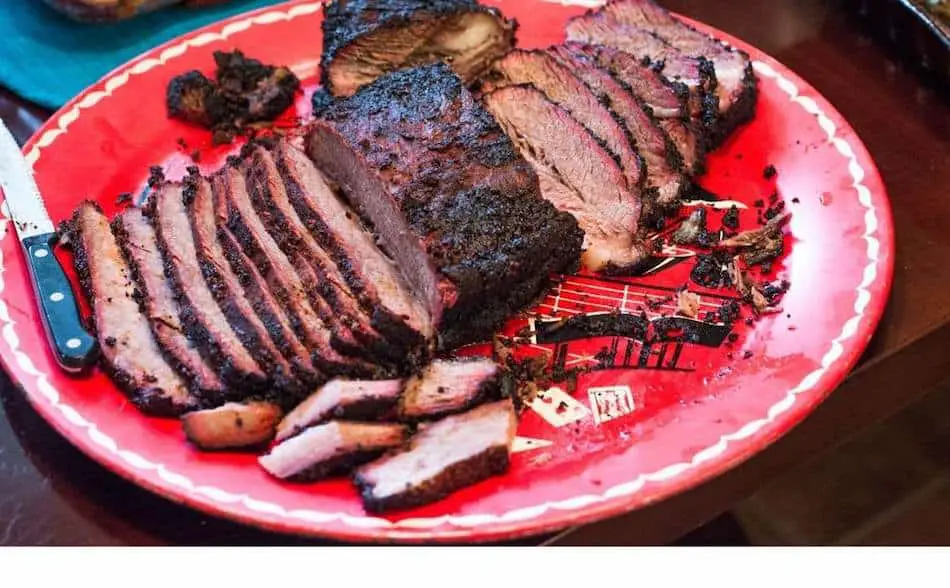
A low-and-slow brisket has a better bark
One of the key differences between a hot and fast and a low and slow brisket is the bark, or the outer crust of the meat. The bark is formed by a combination of dehydrated meat, smoke, and seasonings, and it takes time to develop.
On a hot and fast brisket, the meat does not spend enough time in the smoker for the bark to form properly. As a result, the bark may be less pronounced and may not have the same depth of flavor as a low and slow brisket. Some people try to improve the bark on a hot and fast brisket by starting the cooking process at a lower temperature, such as 250°F, and allowing the meat to smoke for about 5 hours before increasing the temperature and wrapping the brisket.
This method allows the bark to form and gives the rub a chance to fuse with the meat, but it still results in a brisket that is cooked faster than a traditional low and slow brisket.For more info on brisket bark, check out this: “9 Ways To A Crispy Brisket Bark – Never Have Soft Bark Again”
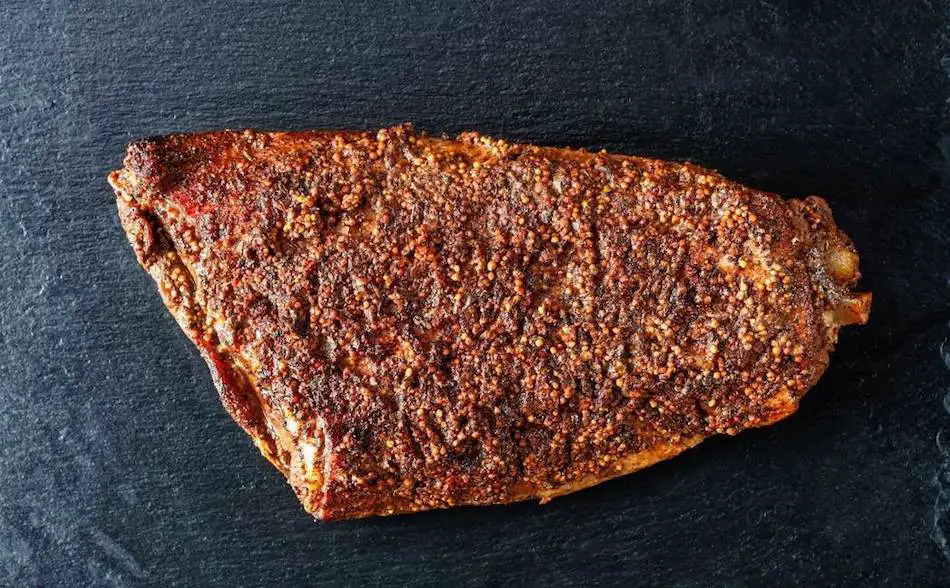
Does a hot-and-fast brisket have a smoke ring?
When comparing slices of brisket cooked using the low and slow method versus the hot and fast method, you will notice that the smoke ring, or the pinkish layer just below the surface of the meat, is more prominent on the low and slow brisket. This is because the low and slow method allows the meat to absorb more smoke flavor over a longer period, resulting in a stronger smoky taste and a more pronounced smoke ring.
A hot and fast brisket will have a lighter smoke ring because it spends less time on the grill or smoker and has less time to absorb smoke flavor. While both methods of cooking brisket can produce delicious results, the low and slow method is generally considered to result in a more traditional, flavorful brisket with a stronger smoky taste. To learn more about the smoke ring here: “The Ultimate Guide to Getting a Perfect Smoke Ring on Your Brisket”
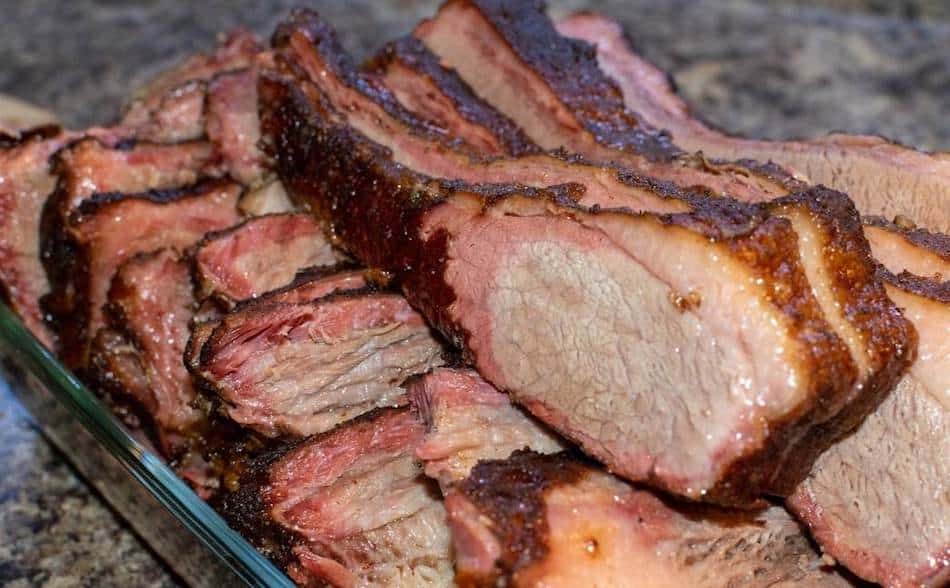
How long does it take to cook?
A low and slow brisket is generally cooked anywhere from 220°F to 250°F over 10 to 12 hours, even longer depending on the size of the brisket. A hot and fast brisket is smoked between 350°F and 400°F between 3.5 hours to 6 hours.
So the main difference between hot and fast and low and slow methods of cooking brisket is the cooking temperature and duration.
The slow cooking process allows the flavors to fully develop and the meat to become tender and juicy. On the other hand, a hot and fast brisket is cooked at a higher temperature, usually between 350°F and 400°F, for a shorter period of time, typically 3.5 to 6 hours. While this method is quicker, it may result in a less tender and flavorful brisket. However, it can be made more moist and juicy by using techniques such as injecting with broth or marinade, wrapping during cooking, and salting the day before.
“Hot And Fast Brisket On A Traeger – 12 Easy-To-Follow Steps”
Hot-and-Fast Brisket Recipe
| Step | Action |
|---|---|
| 1 | Set the temperature of your smoker between 350°F to 400°F. Remove the water pan and fill the hopper. |
| 2 | Place the brisket in your smoker with the brisket point facing the hottest part of the grill. |
| 3 | Allow the brisket to cook for about 1.5 hours to 2 hours. |
| 4 | Remove the brisket, wrap the meat in foil or butcher paper. |
| 5 | Return the brisket to the smoker, and insert a thermometer probe into the middle of the brisket. Cook until the internal temperature of the meat reaches about 195°F. |
| 6 | Check the internal meat temperature every 10 minutes. Once the brisket has reached 203°F and is as tender as butter when you insert the probe, the brisket is done. Remove from smoker. |
| 7 | Allow the brisket to rest for at least one hour in a dry cooler. However, resting for 2 to 4 hours is preferable. |
| 8 | Slice the brisket paying attention to cutting against the grain. |
| 9 | Prior to cooking, choose a brisket with a even covering of fat and as much marbling as you can afford. |
| 10 | When preparing the brisket, trim the fat cap, leaving 1/4 inch on the fat cap. |
| 11 | Brine prior to cooking by sprinkling with kosher salt or sea salt and let it sit in the refrigerator for at least 2 hours. |
| 12 | When seasoning your brisket with your rub, watch the salt content if you are pre-salting in the meat. |
How to plan a low-and-slow cook
Cooking a brisket low and slow is time-consuming, and the entire process sometimes requires 10 to 12 hours or longer when cooking at a low temperature. So it’s understandable that not everyone wants to spend a day and a half managing a brisket.
A popular strategy many people adopt is the overnight brisket. By smoking the brisket overnight, the meat can be served for lunch the following day. However, this can be unsafe as it requires leaving the smoker unattended.
| Brisket Total Cook Time | Start Time | Begin Spritzing | Wrap Brisket | Finish in Oven | Done Time (203°F) | Holding Time In Dry Cooler (1-4 hours) |
| 12 hours | 6pm | 9pm | 12am | 12am | 6am | Between 7am – 10am |
| 15 hours | 5pm | 8pm | 11pm | 11pm | 8am | Between 9am – 12pm |
| 18 hours | 2pm | 5pm | 8pm | 8pm | 8am | Between 9am- 12pm |
Low-and-Slow Brisket Recipe
| Step | Instruction |
|---|---|
| 1 | Set the temperature of your smoker between 250°F and 275°F. |
| 2 | Leave the brisket until the bark hardens and the internal meat temperature goes beyond 150°F, which should be 5-6 hours. |
| 3 | Wrap the brisket in foil or butcher paper, then place it back into the smoker. |
| 4 | Cook for another 4 hours or thereabouts until the brisket reaches doneness at 203°F internal meat temperature, or feels like butter when poked. |
| 5 | Rest the brisket for 1 hour or place in a dry cooler for up to 4 hours. |
| 6 | Prior to cooking, trim the fat cap to 1/4 inch and remove the silver skin underneath the brisket. |
| 7 | Apply a binder (optional) using olive oil or yellow mustard, and then season both sides of the brisket with a barbeque rub. |
Experiment with both methods
The best way to understand the differences between a low and slow and a hot and fast brisket is to try them both and compare the results. One way to do this is to cook two small briskets using these two methods and then compare the results in a blind taste test.
To do this, you can start by cooking one brisket low and slow, using a temperature of around 220°F to 250°F and cooking it for 10 to 12 hours or longer. When the brisket reaches the wrapping stage, you can put it in a conventional oven at the same low temperature to finish cooking it.
For the other brisket, you can increase the temperature of your smoker or grill to around 350°F to 400°F and cook it hot and fast for 3.5 to 6 hours. After both briskets are cooked, you can allow them to rest for a few hours and then slice them for the taste test.
You can conduct the taste test with another person who is unfamiliar with the cooking methods used, to get an unbiased opinion. This can be a fun and informative way to compare the differences between these two methods of cooking brisket.
“Hot And Fast Brisket On A Big Green Egg – Can It Be Done?”
Different smokers make a difference
Different types of smokers and grills may produce different results when cooking a hot and fast brisket. For example, a charcoal smoker may produce a hot and fast brisket with a stronger smoke flavor compared to one cooked on a pellet grill. This is because charcoal smokers tend to produce more smoke, which can infuse the meat with a stronger smoky taste.
Pellet grills, on the other hand, may produce less smoke and therefore result in a brisket with a lighter smoke flavor. Other factors that can affect the flavor and texture of a hot and fast brisket include the type of wood used for smoking, the seasoning and rub used, and the techniques used to keep the meat moist during cooking. Ultimately, the results will depend on the specific smoker or grill being used and the techniques employed by the cook.
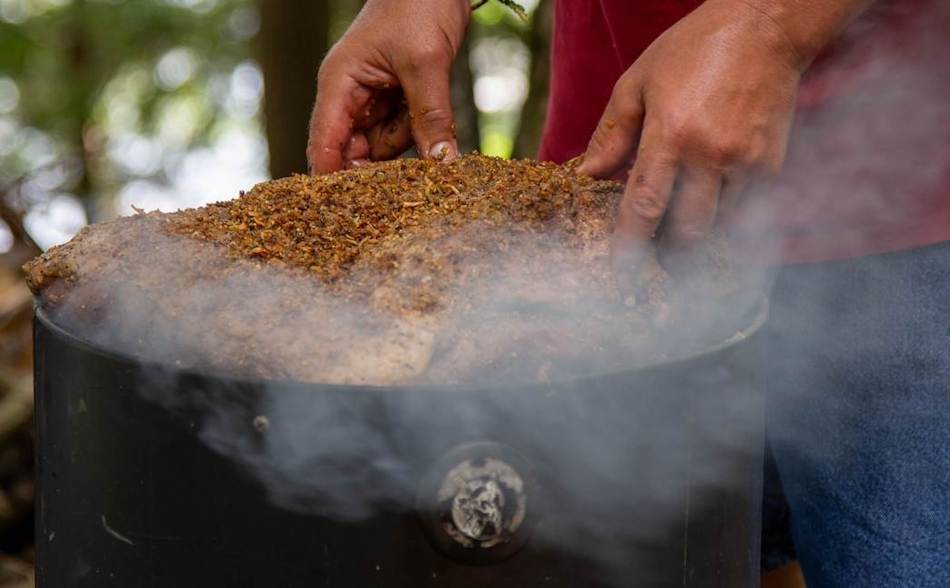
Beef grades make a real difference
When cooking a hot and fast brisket, the USDA beef grade will make a big difference to the final outcome. Brisket is a cut of meat that is naturally tough and requires slow cooking to become tender. Marbling, or the presence of fat within the muscle tissue, can contribute to the tenderness and flavor of the meat.
Select grade beef, which has less marbling, may be less well-suited to the hot and fast method of cooking compared to Prime grade beef, which has a higher level of marbling. This is because the fat in the Prime grade beef can help to keep the meat moist and add flavor during cooking, even at high temperatures.
However, it is important to note that other factors, such as the cooking temperature and duration, the seasoning and rub used, and the techniques used to keep the meat moist, can also impact the quality of the end result.
| Grade | Marbling | Tenderness |
|---|---|---|
| Prime | High | Very high |
| Choice | Moderate | High |
| Select | Low | Moderate |
| Standard | Very low | Low |
| Commercial | Very low | Low |
| Utility | Very low | Very low |
| Cutter | Very low | Very low |
| Canner | Very low | Very low |
My Favorite Brisket Tools
Thanks for checking out this article. I hope you learned a few things. Here are some of my favorite tools I use when smoking brisket that may be useful to you. These are affiliate links, so if you decide to purchase any of these products, I’ll earn a commission. But in all honesty, these are the tools I recommend to my family and friends who are just starting out.
Meat Injector: Injecting meat is a great way to take your barbecue to the next level and help you make competition-style brisket. An injector is the only way you will be able to get flavor and moisture into the middle of the meat. The Beast Injector is a stainless steel injector that is sturdy and affordable. Check the latest price on Amazon here.
Brisket Marinade: The best injection solution on the market is the Butcher BBQ Brisket Injection. This marinade is used in competitions and is made by World Barbecue Champion pitmaster, Dave Bouska. You can find the marinade on Amazon here.
Butcher Paper: Wrapping brisket in butcher paper has become a huge trend in barbeque thanks to Aaron Franklin. Wrapping your brisket in paper will give you a nice brisket bark. However, you can’t just use any old paper, it has to be unwaxed, food grade paper. You can find it on Amazon here.
Brisket Rub: These days I make my own rub when possible, but I always have a few pre-made rubs for when I’m running low. Barbecue guru Malcom Reed produces Killer Hogs, one of the best brisket rubs I’ve found over the years. Another great rub is Slap Yo Daddy, made by brisket master and multiple World Barbecue Champion, Harry Soo.
Meat Thermometer: There are dozens of fancy thermometers on the market, but I still use my trusty TP20. For around $50, I have a high-quality meat thermometer with two probes, and can track the temperature of my smoker with one probe, and my meat with the other probe. The ThermoPro TP20 is an Amazon Best Seller because it’s the easiest thermometer to operate, is durable, highly accurate, and comes with pre-programmed meat settings.
Instant Read Thermometer: Arguably, the second most important tool you need is a fast and accurate instant-read thermometer. These tools play an important role in the latter stages of the cook when the meat needs regular checking in multiple areas. I use the ThermoPro TP19 because it can do everything a ThermaPen can do, but for a fraction of the cost. You can check out the TP19 on Amazon here.
Advanced Thermometer and Automatic Temperature Controller: Once you’re ready to take things seriously, the FireBoard 2 Drive is a six-channel Bluetooth/Wi-Fi thermometer that can monitor up to 6 pieces of meat, control and graph your cook sessions on your smartphone, and attaches to an an automatic blower that will convert your charcoal smoker to a set-and-forget. This is one of the most advanced meat thermometers on the market. You can check it out on the FireBoard website here.
